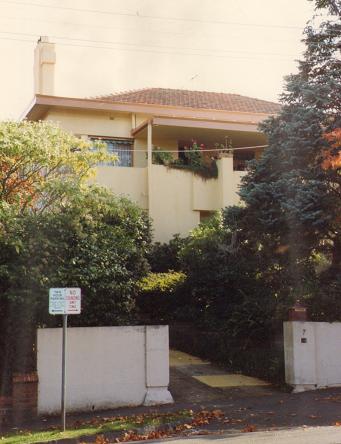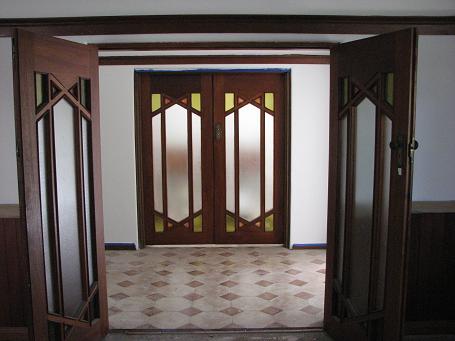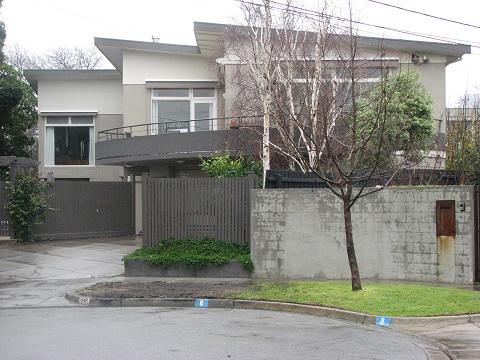Born
in Windsor and raised in Elsternwick, Leslie Gordon Grant commenced his
architectural education in 1919 at Swinburne Technical College,
where, over the next three years, he completed various subjects
(including Carpentry, Design, Perspective, Modelling and Mechanics) as
a day student. In November 1921, Grant obtained a junior position
in the office of the prominent Collins Street architectural firm of
Eggleston & Oakley; the following September, he transferred to
the office of Walter Burley Griffin (1876-1937), who, a few years
before, had been briefly associated with Eggleston & Oakley (in the
capacity of design consultant) on a project to extend Collins House to
its Little Collins Street frontage. Grant joined Griffin's office
as an articled pupil and, until the completed his articles in 1926,
concurrently took further subjects at Swinburne Technical College
(including Building Construction and Applied Mechanics) as a night
student. Grant later undertook additional studies at Melbourne
Technical College (1928) and at the University of Melbourne Architectural
Atelier, where he completed his Diploma of Architectural Design
(1932).
In Griffin's office, the young Leslie Grant initially worked as a junior draftsman and, by his own admission, gained "valuable knowledge while working on the details of the Capitol Theatre" (1921-24). In another reminiscence, Grant recalled also working on the Orpheum shops and (unbuilt) theatre at Armadale (1922), the Palais Picture Theatre at St Kilda (1925), the Langi flats in Toorak (1925-26), as well as "Castlecrag residences, various incinerators, knitlock houses and numerous project designs". Appointed as Griffin's Chief Draftsman in January 1927, Grant retained that position until he left the office almost a decade later. Such was Grant's reputation within the office that, as he noted in his 1928 application for registration as an architect, he took "full control in the absence of Mr Griffin or his partner Mr Nicholls". Two years before his death in 1978, Grant told a journalist that "I absolutely considered it an honour and privilege to be there. I wouldn't have changed it for anything. Life in Griffin's office was never dull".
Like all members of Griffin's staff, Grant was allowed the right of private practice provided that any profits from outside jobs were shared amongst the entire office. In March 1927, Grant called tenders for the erection of a "brick and roughcast residence for David W Bond, esquire". To date, only one other independent and fully verified project by Grant has been identified from his years in Griffin's office: a "brick shop and dwelling" in Glen Eira Road, Elsternwick, for which tenders were called in October 1934. Another project, for a striking Griffinesque attic-storey house in Victoria Street, Williamstown (1935) has been tentatively ascribed to Grant in the City of Williamstown Heritage Study, albeit without any documentary evidence.
When Grant finally left the Griffins' employ after almost 15 years, Walter Burley Griffin himself wrote a glowing letter of recommendation, stating that "he has both my confidence and authority to instruct contractors in all matters on my behalf, and I have found that his duty has been ably carried out, both to my clients and my own satisfaction". After leaving the Griffins in 1936, Grant was briefly associated with architect Clifford J Cummings, with whom he collaborated on some additions to a shop in Glenhuntly Road, Elsternwick. Towards the end of the same year, Grant left Australia to travel overseas. He worked for various architectural practices in England and the United States, including the office of McKim, Mead & White in New York and unspecified others in San Francisco. He had returned to Australia by mid-1938, when he was employed in the Melbourne office of architect C N Hollinshed (1899-1993); Grant's signature appears on some correspondence relating to Hollinshed's Horsham Town Hall (1937-39), and the two men are also known to have collaborated on the design of an unlocated two-storey house in Balwyn (1938). By 1939, however, Grant had transferred to the office of Stephenson & Turner.
In 1942, Leslie Grant entered into partnership with Irish-born engineer W J Grassick (1884-1964), who had an office in Collins House and may well have known Grant when the latter was employed by Eggleston & Oakley in the same building two decades earlier. After about a year with Grassick, Grant continued on his own; his architectural career continued into the post-war period, although little is known of its extent. The relatively few projects identified to date are residential in nature, and include houses in Brighton, Caulfield and Beaumaris, all dating from the early 1960s. Grant was still in practice as late as November 1976, when he was interviewed by a journalist on the ocassion of the centenary of Walter Burley Griffin's birth. He died barely two years later, on 7 December 1978.
In Griffin's office, the young Leslie Grant initially worked as a junior draftsman and, by his own admission, gained "valuable knowledge while working on the details of the Capitol Theatre" (1921-24). In another reminiscence, Grant recalled also working on the Orpheum shops and (unbuilt) theatre at Armadale (1922), the Palais Picture Theatre at St Kilda (1925), the Langi flats in Toorak (1925-26), as well as "Castlecrag residences, various incinerators, knitlock houses and numerous project designs". Appointed as Griffin's Chief Draftsman in January 1927, Grant retained that position until he left the office almost a decade later. Such was Grant's reputation within the office that, as he noted in his 1928 application for registration as an architect, he took "full control in the absence of Mr Griffin or his partner Mr Nicholls". Two years before his death in 1978, Grant told a journalist that "I absolutely considered it an honour and privilege to be there. I wouldn't have changed it for anything. Life in Griffin's office was never dull".
Like all members of Griffin's staff, Grant was allowed the right of private practice provided that any profits from outside jobs were shared amongst the entire office. In March 1927, Grant called tenders for the erection of a "brick and roughcast residence for David W Bond, esquire". To date, only one other independent and fully verified project by Grant has been identified from his years in Griffin's office: a "brick shop and dwelling" in Glen Eira Road, Elsternwick, for which tenders were called in October 1934. Another project, for a striking Griffinesque attic-storey house in Victoria Street, Williamstown (1935) has been tentatively ascribed to Grant in the City of Williamstown Heritage Study, albeit without any documentary evidence.
When Grant finally left the Griffins' employ after almost 15 years, Walter Burley Griffin himself wrote a glowing letter of recommendation, stating that "he has both my confidence and authority to instruct contractors in all matters on my behalf, and I have found that his duty has been ably carried out, both to my clients and my own satisfaction". After leaving the Griffins in 1936, Grant was briefly associated with architect Clifford J Cummings, with whom he collaborated on some additions to a shop in Glenhuntly Road, Elsternwick. Towards the end of the same year, Grant left Australia to travel overseas. He worked for various architectural practices in England and the United States, including the office of McKim, Mead & White in New York and unspecified others in San Francisco. He had returned to Australia by mid-1938, when he was employed in the Melbourne office of architect C N Hollinshed (1899-1993); Grant's signature appears on some correspondence relating to Hollinshed's Horsham Town Hall (1937-39), and the two men are also known to have collaborated on the design of an unlocated two-storey house in Balwyn (1938). By 1939, however, Grant had transferred to the office of Stephenson & Turner.
In 1942, Leslie Grant entered into partnership with Irish-born engineer W J Grassick (1884-1964), who had an office in Collins House and may well have known Grant when the latter was employed by Eggleston & Oakley in the same building two decades earlier. After about a year with Grassick, Grant continued on his own; his architectural career continued into the post-war period, although little is known of its extent. The relatively few projects identified to date are residential in nature, and include houses in Brighton, Caulfield and Beaumaris, all dating from the early 1960s. Grant was still in practice as late as November 1976, when he was interviewed by a journalist on the ocassion of the centenary of Walter Burley Griffin's birth. He died barely two years later, on 7 December 1978.
Select List of Projects
| 1927 1934 1936 1938 1960 1963 1965 | Residence for David W Bond, 7 Rochester Road, Canterbury Shop and residence, Glen Eira Road, Elsternwick Additions to shop, Glenhuntly Road, Elsternwick (in association with Clifford Cummings) Residence, Balwyn (in association with C N Hollinshed) Residence, Tynefield Close, Brighton Residence, Cantala Avenue, Caulfield Residence, Bruce Avenue, Beaumaris |
 | |
| Bond Residence at Rochester Road, Canterbury (1927) (photograph by Simon Reeves, 1995) |
 | |
| Bond Residence at Rochester Road, Canterbury (1927) (photograph by Simon Reeves, Built Heritage Pty Ltd) |
 | |
| Residence at Tynefield Close, Brighton (1960) (photograph by Simon Reeves, Built Heritage Pty Ltd) |
